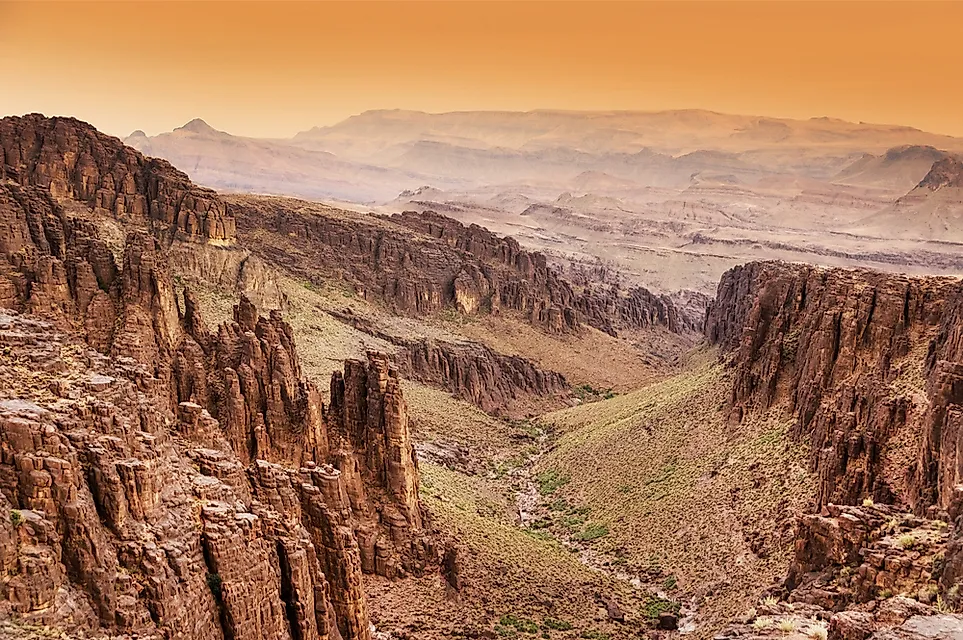Where Is the Anti-Atlas Mountain Range Located?

The Anti-Atlas mountain range, also known as Lesser Atlas, is part of the Atlas Mountains found in Morocco. The Anti-Atlas range covers a distance of about 310miles in length, running from east of the Atlantic Ocean to the southwest, and extends northeast to the city of Ouarzazte, and further to the city of Tafilalt, which neighbors the Sahara. The Sahara desert borders the Anti-Atlas range on the southern side. Most of the the region is rocky and lacks vegetation. Although the land is barren and dry, small streams form in isolated places and serve as the primary source of water. The region is sparsely populated with small villages far apart. Small castles, known locally as kasbahs, characterize the landscape. Kasbahs were traditionally an essential place for trading and shelter. The average heights of the Anti-Atlas range is between 8,200 ft and 8,900 ft, although some peaks reach much higher elevations.
Climate
The climate around the Anti-Atlas range is considered arid and classified as part of the Saharan climate zone. The range receives less than 200 mm of rainfall annually. The High Atlas range separates the Anti-Atlas from the Mediterranean Sea, and as a result, little or no moist winds reach the Anti-Atlas. The absence of wet wind on the Anti-Atlas range explains the low levels of precipitation.
Vegetation
The northern part of the Anti-Atlas range has more vegetation and is considered favorable for cultivation, whereas the southern part is much drier with scattered thorny bushes. The southern part of the Anti-Atlas range is slowly becoming desert, due to overgrazing.
Formation
The Anti-Atlas range formed as a result of the continental movement, namely when the African and Eurasian plates collided, forcing the plates to uplift. Due to prolonged collision, the two plates raised to heights higher than the Himalayas. Since the layers of the Anti-Atlas mountain are mainly lime and sandstone, continuous erosion has significantly reduced its height.
Smaller Subranges
The Anti-Atlas mountain range extends east to form the Jbel Saghro range. The Jbel Sirwa range is located within northern part of the Anti-Atlas, which connects to High Atlas. The Jebel Bani range is lower in elevation compared to parts south of Anti-Atlas. The Jbel Saghro range is considered very dry, with little or no vegetation.
Towns in the Region
The area around the Anti-Atlas range is traditionally known as the Berber region, which was settled by the Shilha people. The area is sparsely populated, with no major cities, and Tafraoute is the main town. Tafraoute is an ideal place to view the Anti-Atlas range and visit Ameln Valley, which is famous for the “Blue Stones Rocks” and rock paints. Taroudant is a town located north of the Anti-Atlas range, which is a friendly place to explore the mountains. There is a Berber market in Taroudant, which is open every Sunday. There is an international airport in the nearby town of Agadir, which provides easier access to Taroudant and Tafraoute.
Human Activities
The Anti-Atlas range is mostly inhabited by the Shilha people, who extend to the High Atlas. The Shilha people are traditionally known to be farmers who also keep animals. Most of the land in the southern region is used for grazing, while the northern part is used for farming. Other human activities in the Anti-Atlas region include trading. The region also attracts many tourists visiting the Anti-Atlas range and rock paintings. Most of the land surrounding the Anti-Atlas range has been left unsettled, as settlers migrated elsewhere due to the harsh and dry conditions.











